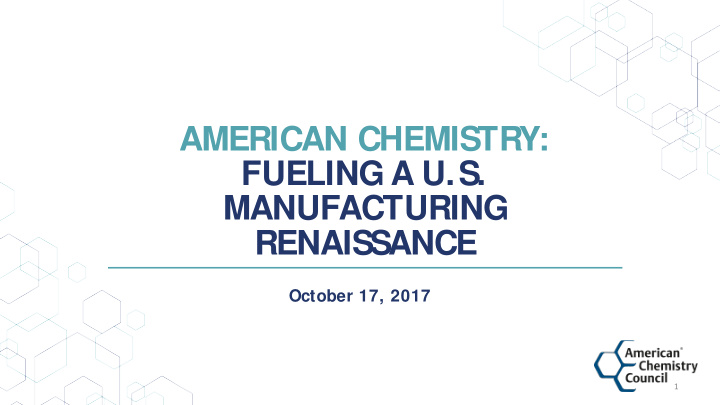



AMERICAN CHEMISTRY: FUELING A U.S. MANUFACTURING RENAISSANCE October 17, 2017 1
2
PROMOTING POLICIES TO DRIVE A MANUFACTURING RENAISSANCE Relat ive Posit ion of U.S. (2006-2016) (Petrochemical Product ion Cost s) HIGH OTHER NORTHEAST ASIA 2016 ESTIMATED Production Costs* ($/lb.) WESTERN EUROPE RELATIVE POSITION CHINA OF UNITED STATES UNITED IN 2006 STATES MIDDLE IN 2016 EAST LOW *Based on estimates from best available data
Oil-to-Gas Ratio: A Proxy for U.S. Petrochemicals Competitiveness When the ratio is above 7, U.S. competitiveness is enhanced. Current ratio remains very favorable for U.S. competitiveness Growth likely to slow but be offset by stimulative consumer effect 4
Chemical Inves tment U.S . S hale Gas More than 310 projects and $185 billion 30-year supply that can be profitably in potential capital investment produced at $4.00 per million BTUs announced as of September 2017 or less … Up from 97 projects and $72 billion as U.S. chemical industry benefits from of March 2013 lower costs for energy and feedstock 62% is by firms based outside the U.S. ACC data IHS data
Project Status by Investment Complete Under Construction Planned Delayed/ Uncertain 8% 6 new ethane crackers 20% are currently under construction in U.S. Over $86 billion in 45% new projects 28% have been completed or are currently under construction
Manufacturing Construction Spending by Industry - 2016 $ billions 40 35 30 48% 25 of 20 15 total 10 15 10
State of U.S. Manufacturing Decrease in Manufacturing Growth in manufacturing renaissance due materials & costs encourages to increased downstream domestic access to natural sectors expansion gas from shale
Economic C ontributions From Increas ed C hemical Indus try Inves tment 823,000 $310 billion Permanent NEW j obs by 2025 Permanent NEW U.S . economic output by throughout the U.S . economy from 2025 from $95 billion in new chemical $95 billion in new chemical industry industry output output Based on $179 billion in cumulative U.S. chemical investment planned, underway, or completed as of July 2017
U.S. Feedstock Advantage Will Grow Chemical Exports in the Years Ahead
Plastics Processor Projects • ACC is tracking nearly 700 plastics processor projects. • 1/3 New Construction New • 2/3 Expansions Construction — Adding capacity — New lines — New equipment Expansions • Since June 2012, plastics processor projects have been announced by over 550 companies in over 46 states. S ource: Plast ics News, ACC analysis NOTE: The data is based on publicly available information, which is believed to be accurate, but have not been independently verified by ACC. 11
Announced Plastics Processor Projects by State S t at es where t en or more proj ect s have been announced since June 2012 70 60 Number of Announced Projects 50 40 30 20 10 0 IN OH TX C NC KY TN GA PA MN CA MA VA NY MO MI WI IL AL FL CT S S ource: Plast ics News, ACC analysis NOTE: The dat a is based on publicly available informat ion, which is believed t o be accurat e, but have not been independent ly verified by ACC. 12
The expected increases in production volumes will result in an additional 1.8M shipments annually Annual number of additional shipments required to meet expected production volumes in 2020 By shipment mode Need for additional 1,800k pipelines, ports & truck services to move 810k TEUs shipments Recent success in Texas – 720k ACC-supported legislation FTLs signed into law creating 30-35 mile corridor 270k allowing heavier weights rail cars Rail Truck Marine Total 13 PwC | Transport ing growt h: Delivering a chemical manufact uring renaissance
Rail, Transportation & Infrastructure (RTI) Infrastructure Plastic Pipes Rail Ensuring access & reasonable practices Promoting Promoting choice & for moving products: competition, open competition to • Ports minimizing fees & create new markets & • Highways ensuring safety business opportunities 14 • Pipelines
Open Competition • Pursuing federal & state legislation requiring open, competitive bidding procedures By Steve Russell, Vice President, Plastics Division, American Chemistry Council on May 19 for all materials May 17, 2017 Open Letter to Congress: Support “Open Competition” in Infrastructure Projects • Working with congress to develop federal legislation to introduce later this year • Pending legislation in MI & OH • Enhance relationships & secure support to demonstrate potential savings 15
Trade Defending & creating open markets for the $100B+ potential in new plastics & chemical exports Global regulatory alignment to reduce compliance costs
Principles for a Modernized NAFTA Maintain duty-free trade for all qualifying products Modernize the Rules of Origin Modernize border measures & trade clearance disciplines Strengthen regulatory coherence Promote greater alignment on chemical regulation
Tax Promoting reform that protects chemical manufacturers Ensuring industry has seat at the table & is positioned as constructive partner Significant pressure to get tax reform done – critical victory for Trump Administration – draft plan released late Sept.
Guiding Principles for Corporate Tax Reform Produce fair, simpler & internationally competitive system that promotes economic growth and job creation Recognize role of manufacturing and reflect importance of capital cost recovery and incentives for R&D Adopt competitive territorial system Provide substantial tax rate reduction Produce a “level playing field” concept so American companies can compete with foreign investors
Marketplace Challenges
Chemistry Remains Under Attack Consumer Activism Marketplace Deselection Local Bans State Regulation Federal Regulation
Government Chemical Value Chain chemicals safety decision- management assessments making systems ACC’s Fundamental Principle: Risk, not hazard, should guide decision-making alongside lifecycle considerations & product sustainability impacts
Questions / Discussion
Recommend
More recommend